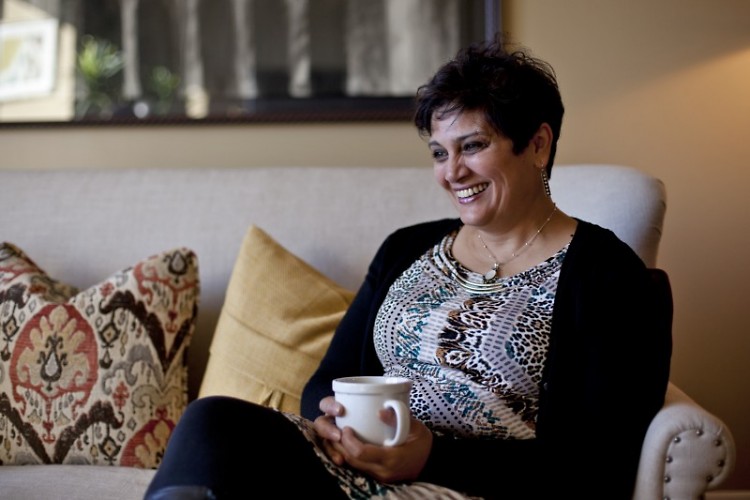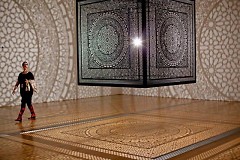Not many in our community were surprised that Anila Quayyum Agha’s work “Intersections” won this year. We knew it, as soon as we walked into the room where her installation hung.
But Agha wouldn’t let herself go there.
“To tell you the honest truth, I know the work is good... but it’s a little heavy," she says. "There were so many beautiful works throughout the city that I had tough competition.”
Agha, who took home the Grand Prize for public vote as well as earning the category award for Installation and coming in with a tie in the Jurors’ Grand Prize, says she first heard about ArtPrize when Kevin Buist spoke at an event for the Indianapolis Downtown Artists & Dealers Association (IDADA) in late 2011.
“I listened to him and I thought, this is such an amazing idea, because yes, from a snobbish point of view it may not be all professionals or it may be student work or people who are not full-time artists, but to my mind it was very egalitarian," she says. "There was a by-product of that idea: everybody got on board in the city to improve their economy, their culture and their attitudes. So they demonstrated the ability to be open-minded, to be interested in being democratic, because the process is very inclusive."
It wasn’t until this year that she decided to add her own submission to the ArtPrize website. She “requested a match” from the Grand Rapids Art Museum (GRAM) immediately, knowing that her work would require a large space if it were to work. Just days later, she received a response from Cindy Buckner, Associate Curator at the GRAM that curated the ArtPrize exhibit. It didn't take long for a match to be made, and “Intersections” won over the admiration and interaction of both jurors and the general public alike.
Her work, a sculptural die-cut wooden box, is neatly consumed by intricate patterns referencing the Alhambra. It’s hung from the ceiling, calibrated specifically to cast mathematically pristine shadows from one single light source within the box. The box itself is massive and leaves a mark, but it’s the light throwing shadows around the room and anyone in it that creates a conversation. It immediately requires the viewer to be a part of the work. It is a contemplative, many layered piece.
How many of the people that viewed it - and voted for it- saw those layers? Is that a concern for Agha?
“Sometimes extreme beauty can bring you to tears," she says. "There are ways to rise above ourselves and create something that would be bigger and more universal... That’s what makes artwork poetic- if you can rise above yourself and still connect on a level where people can feel like they are a part of each other. This work hopefully does that. It rises above itself, where it can connect people on that level where you don’t need to have words to make it work for you.”
Our interaction with Agha’s work- whether we know about the Alhambra and its symbolism and purpose, or Agha’s childhood and country of nationality, or her experience as a woman, or her desire to see people connect and overcome fear of “the other,” or her work with culture clashes or our interactions with public and private space- still affects us deeply.
But those conversations about inclusion and understanding are ones we don't want to miss in the work.
Anila Quayyum Agha, pronounced Aa-knee-la Ka-yoom Aa-ga, grew up in Pakistan, with a mother who had a talent for drawing and interior decorating and a highly educated father, in a home with a large library full of books. In 5th grade, she read War and Peace. Though she now knows she didn't understand half of it, she credits this high value placed on education to her parents' influence on her educational and career pursuits. It was about that time, as well, that Agha created a watercolor of a sunset for an assignment at school.
“Anila, you are going to be an artist,” her teacher pronounced upon seeing the finished work.
From then on, says Agha, she was caught up in the idea. She insisted on going to a co-ed college, which was quite a controversial thing to do in Pakistan at the time. Her parents worried about her and their reputation, with a daughter attending school with boys, but Agha insisted. Once there, her parents saw that it was the right choice, she says, and she graduated with a BFA in textiles in 1989 from the National College of Arts in Lahore, Pakistan.
Not long after her studies, Agha moved to the United States and discovered that adjusting to a different culture was vastly more difficult than she expected.
“I felt like I needed a challenge. I had no idea how much of a challenge it would be,” she says. “When you move culturally, it’s not just the language that changes. It’s also the body language that changes. The food is different. The way people relate to each other is different.”
"Intersections" is not the only work that talks about overcoming cultural differences. Agha has created other work, such as her installation “My Forked Tongue,” that addresses those difficulties. From those experiences and her work addressing these issues as an artist, she's gained an understanding of what can connect us in the middle of all our differences.
“The only thing that connects us as people is compassion. We have to be compassionate to each others’ needs,” she says. “to listen more so we can understand.
Agha’s travels to the south of Spain and the Alhambra inspired "Intersections." Having experienced the exclusion of women from holy spaces growing up, this very different history of peaceful times between Muslims, Jews and Christians under the Caliphate struck her as a different way of approaching intersecting cultures.
“If you think back on history, that’s how Spain was, before the Crusades,” she says. “Under [the Caliph’s] rule, they were very tolerant of the Jewish communities and the Christian communities and it was a time when people had discourse that was across the barriers. People talked to each other and they felt comfortable. Craftspeople were there, the artists were there, philosophers were there- and they were all communicating."
Her visit sparked a study of the history behind the Alhambra and the cultural interactions around it.
"That has to show us that there is a way to cross this religious and political divide that we are so conscious of now, the intolerance that you see around you. So if we can have a beacon from a time period that people were not that educated, why can’t we have it now when a lot of people are educated? We have advanced so much in so many ways,” she says. “And we’re still fighting over the basic things. If we could have discourse back in those days, I’m sure we can have it again.”
Agha knows this is an idealistic way to look at the world. But she also believes it's possible.
“It’s easy to fear people or things that are different from ourselves. But usually the other person is just as scared- really. So if you make overtures to each other, I think that may be the way to connect,” she says. “Finding a way to connect is the key.”
The Rapidian, a program of the 501(c)3 nonprofit Community Media Center, relies on the community’s support to help cover the cost of training reporters and publishing content.
We need your help.
If each of our readers and content creators who values this community platform help support its creation and maintenance, The Rapidian can continue to educate and facilitate a conversation around issues for years to come.
Please support The Rapidian and make a contribution today.


